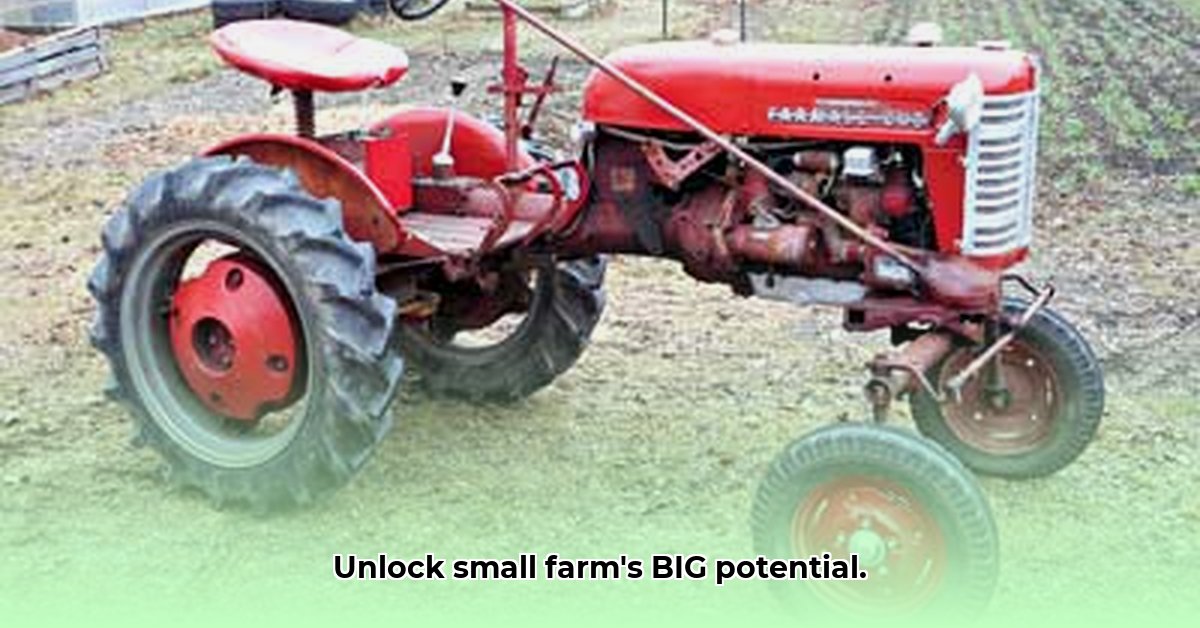
Choosing the right tractor can significantly impact your farm's efficiency and sustainability. This guide focuses on Case IH's smaller Farmall tractors, analyzing their suitability for various farm sizes and sustainable practices. We'll explore different models, comparing their capabilities to help you make an informed decision. For more options, check out small tractor options.
Understanding Your Needs: Choosing the Right Small Farmall Tractor
Before diving into specifics, consider these crucial factors:
- Acreage: How much land do you need to cover? Smaller farms often benefit from more compact and fuel-efficient models.
- Tasks: What jobs will the tractor perform? Haying, tilling, mowing, and other tasks require different power and attachment capabilities.
- Budget: Small Farmall tractors vary in price. Set a realistic budget before you begin your search.
- Future Expansion: Consider potential growth. Buying a more powerful model now may prevent future upgrades.
Small Farmall Tractor Models: A Detailed Comparison
The Case IH Farmall series offers several small tractors, each suited for different farm sizes and tasks. Below, we compare popular models, focusing on key specifications and sustainability considerations. Note that specifications may vary slightly depending on the year of manufacture and additional features. Refer to official Case IH documentation for the most accurate information.
Model Comparison Table:
| Model | Engine Horsepower (HP) | Transmission Type | PTO Horsepower (HP) | 3-Point Hitch Capacity | Key Features | Sustainability Considerations |
|---|---|---|---|---|---|---|
| Farmall 25C | 25 | Hydrostatic | 18 | Light-duty | Compact, highly maneuverable. | Fuel-efficient for smaller-scale operations; relatively low emissions. |
| Farmall 35C | 35 | Hydrostatic | 25 | Medium-duty | Increased capacity, more power. | Balances power with fuel efficiency for medium-sized farms. |
| Farmall 45C | 45 | Hydrostatic | 35 | Medium-duty | Versatile, robust power. | Fuel consumption should be carefully weighed against power output relative to acreage. |
| Farmall 55C | 55 | Hydrostatic | 40 | Medium-duty | Enhanced power and efficiency. | Ideal for larger operations demanding higher power; fuel economy improvements are significant. |
Farmall 25C: The Compact Choice
The Farmall 25C is ideal for smaller operations where maneuverability is key. Its compact size excels in tight spaces, perfect for hobby farms or limited acreage. The hydrostatic transmission offers smooth and easy operation. Isn't ease of use a significant factor in long-term sustainability, reducing operator fatigue?
Farmall 35C: Balancing Power and Efficiency
The Farmall 35C offers increased capacity and power over the 25C, handling a wider array of tasks. Its versatility makes it well-suited for medium-sized farms needing a robust yet maneuverable tractor. But how does its fuel efficiency compare to larger models on similar tasks?
Farmall 45C: Versatile Power for Medium-Sized Farms
This model strikes a balance between power and efficiency. Its increased horsepower tackles tougher jobs while maintaining reasonable fuel consumption. For medium-sized farms, is the added power worth the increased fuel cost? This is key to assessing its sustainability.
Farmall 55C: Power and Efficiency for Larger Operations
The Farmall 55C, the most powerful model in our comparison, is designed for larger farms demanding high performance. It features improved fuel economy compared to older models. How does its overall fuel efficiency contribute to your farm's environmental footprint over its lifespan?
Pros and Cons of Small Farmall Tractors
Before you decide, let's weigh the advantages and disadvantages:
Advantages:
- Versatility: Handle a wide range of tasks.
- Maneuverability: Compact size for easy navigation in confined areas.
- Fuel Efficiency: Newer models offer improved fuel economy.
- Ease of Maintenance: Generally easier to maintain and repair than larger tractors.
- Lower Initial Cost: Typically cheaper than larger tractors.
Disadvantages:
- Limited Power: Not ideal for heavy-duty tasks.
- Lower Payload Capacity: Lower lifting capacity compared to larger models.
- Limited Lifecycle Assessment Data: Comprehensive sustainability data is often lacking for many tractor models, hindering a complete assessment of their long-term environmental impact. More research is needed in this area.
Optimizing Sustainability: Beyond Tractor Selection
Sustainable farming extends beyond the tractor's choice. Here's how to maximize environmental responsibility:
- Precision Farming: GPS-guided technology minimizes input waste.
- Fuel-Efficient Practices: Efficient driving techniques and regular maintenance reduce fuel consumption.
- Regular Maintenance: Ensures peak efficiency and extends the tractor's lifespan.
- Proper Storage: Protects the tractor, reducing the need for frequent replacements.
A Final Word: Making the Right Choice
Choosing a small Farmall tractor is a significant investment. Consider your farming style, acreage, and budget. Consult with experienced farmers or Case IH dealers for personalized advice. By carefully evaluating your needs and weighing the pros and cons, you can choose a tractor that optimizes both productivity and sustainability. The lack of comprehensive lifecycle assessment data currently limits a fully informed sustainability analysis. More research is needed to fully understand the long-term environmental impact of these tractors.